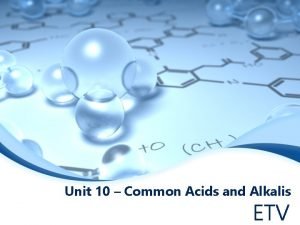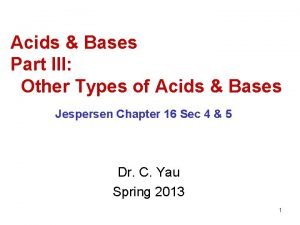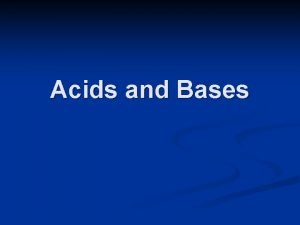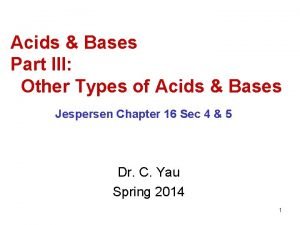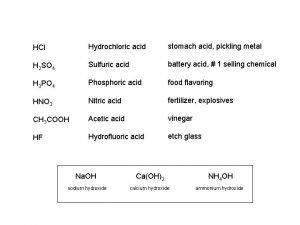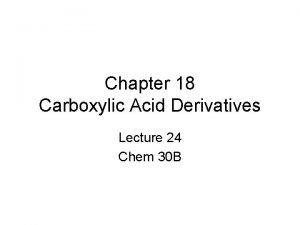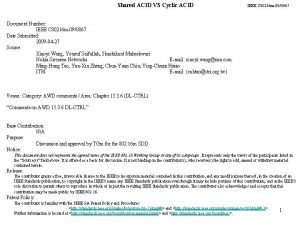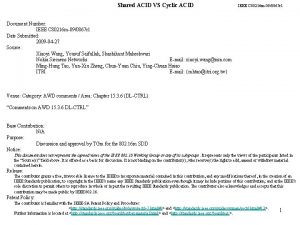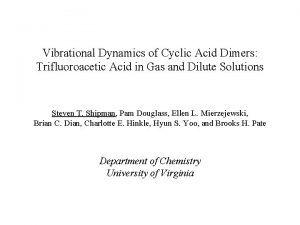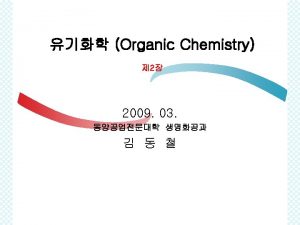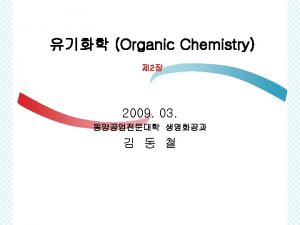Shared ACID VS Cyclic ACID IEEE C 80216






- Slides: 6

Shared ACID VS Cyclic ACID IEEE C 80216 m-09/0867 Document Number: IEEE C 80216 m-09/0867 Date Submitted: 2009 -04 -27 Source: Xiaoyi Wang, Yousuf Saifullah, Shashikant Maheshwari Nokia Siemens Networks E-mail: xiaoyi. wang@nsn. com Ming-Hung Tao, Yan-Xiu Zheng, Chun-Yuan Chiu, Ying-Chuan Hsiao ITRI E-mail: {mhtao@itri. org. tw} Venue: Category: AWD comments / Area: Chapter 15. 3. 6 (DL-CTRL) “Comments on AWD 15. 3. 6 DL-CTRL” Base Contribution: N/A Purpose: Discussion and approval by TGm for the 802. 16 m SDD Notice: This document does not represent the agreed views of the IEEE 802. 16 Working Group or any of its subgroups. It represents only the views of the participants listed in the “Source(s)” field above. It is offered as a basis for discussion. It is not binding on the contributor(s), who reserve(s) the right to add, amend or withdraw material contained herein. Release: The contributor grants a free, irrevocable license to the IEEE to incorporate material contained in this contribution, and any modifications thereof, in the creation of an IEEE Standards publication; to copyright in the IEEE’s name any IEEE Standards publication even though it may include portions of this contribution; and at the IEEE’s sole discretion to permit others to reproduce in whole or in part the resulting IEEE Standards publication. The contributor also acknowledges and accepts that this contribution may be made public by IEEE 802. 16. Patent Policy: The contributor is familiar with the IEEE-SA Patent Policy and Procedures: <http: //standards. ieee. org/guides/bylaws/sect 6 -7. html#6> and <http: //standards. ieee. org/guides/opman/sect 6. html#6. 3>. Further information is located at <http: //standards. ieee. org/board/pat-material. html> and <http: //standards. ieee. org/board/pat >. 1

IEEE C 80216 m-09/0867 How to transmit ACID in GRA, option 1 • Option 1: use cyclic ACID method. Whenever MS is added to a group, an initial ACID is assigned and a set of ACIDs is reserved for this MS. And MS will cyclically use ACID for each GRA_IE : (ACID++) mod N_ACID for every GRA IE received (initial transmission). • Option 2: group ACID. In every GRA_IE, a 2 -3 bits group ACID is transmitted. All the MS shared the same ACID for this transmission. • In both options, retransmission will use the same ACID as the initial transmission does. 2

IEEE C 80216 m-09/0867 Issues on cyclic ACID • Highly rely on MAP decoding. – What happened when one GRA_IE is missed by one MS? MS doesn’t know there is a GRA_IE transmitted and won’t do ACID++ but BS will do. Then for next transmission, the ACID used by MS is different from that of BS’s, which will essentially cause confusion in HARQ retransmission. – The reason of having that issue is BS doesn’t know MS failed to decode the GRA_IE. – However, shared NAK channel on each GRA_IE will be a big overhead. It’s too luxury. Besides, even a shared NAK channel is there, BS only know there is at least one MS failed to decode the GRA_IE, but still doesn’t know which one. • The only way to avoid such issue is MS and BS periodically do ACID++. For example, if the period is 20 ms. Then within this 20 ms, only one GRA_IE could be transmitted for one group and all the user will use concurrent ACID, and in next 20 ms, all MSs shall make ACID++ no matter received GRA_IE or not. – This results a big constraint on the GRA. Within one period, only one ACID could be transmitted, this actually limited GRA to Vo. IP (small packet arrives periodically). Other traffic, e. g. gaming (small packet but not arrives periodically) can’t use GRA at all. – We already have PA for Vo. IP, then we limit GRA for Vo. IP again? – Besides, because of jitter, Vo. IP DL doesn’t arrive so periodically. It will introduce more delay on the Vo. IP packet if we have such limitation (one GRA_IE for a certain period) 3

IEEE C 80216 m-09/0867 Issues with shared ACID, option 2 • It’s difficult to find a common ACID for all MS within a group? – When MS is in a group, BS will reserve a set of ACID for GRA. Normal HARQ won’t use those ACID. Then it’s easy to find a common ACID for a group of MSs. – When MS is adding into a group and a GRA_IE, and the ACID BS want to use for GRA is now used by another unicast HARQ process. BS still can send a GRA_IE with that ACID. And MS shall abandon the existed HARQ process immediately. (ACID used by GRA IE will eliminate all exist HARQ process with the same ACID if any) • Overhead – The number of ACID reserved for GRA should be limited to 4 or 8, so 2 -3 bits are enough. – GRA_IE is a much bigger message compares to normal A-AMAP. 2 -3 bits shouldn’t be a big issue. 4

IEEE C 80216 m-09/0867 Conclusion • The drawback of cyclic ACID (option 1) is that 1. it’s rely on MAP decoding too much. Any missing of GRA_IE will result in ACID mismatch. 2. To solve that, we have to limit GRA for periodical traffic like Vo. IP. But it will increase the packet delay and then GRA and PA are all targeting at Vo. IP, redundant. • The drawback of Shared ACID (option 2) could be solved by some implementation method. • We recommend to adapt Shared ACID (option 2) in the GRA_IE. 5

IEEE C 80216 m-09/0867 Proposed text Replace table 663 with following table Syntax Size Notes Group Resource Allocation_IR { A-MAP IE Type 4 A-MAP IE types distinguish between UL/DL, SU/MU, OL/CL MIMO operation, persistent/non-persistent allocation, basic/extended IEs including GRA Resource Offset [6][8] Indicates starting LRU for resource assignment to this group ACID [4 bits] [2 -3 bits] HARQ channel ID, retransmission and new transmission shall use the same ACID for HARQ combination AI_SN 1 bit Indicate whether it’s new packet or retransmission SP_ID 2 bit SP_ID for all the MSs user bitmap variable Bit length is according to the definition in Group maintenance message for (i=0; i<Size of user bitmap; i++){ if (user bitmap[i]==1) { Resource Assignment [3] or [4] depending on configuration Bitmap to indicate MCS/resource size for each scheduled user } } } 6
